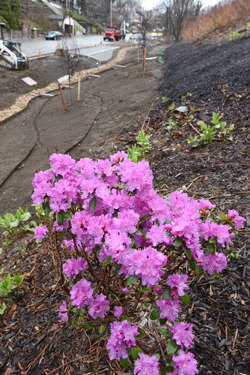Bioswale project helps reduce storm water and is beautiful
Posted on: May 16, 2018 | Written By: Doug Oster |
Protecting Pittsburgh’s rivers is a passion for Megan Zeigler. In fact, she jokingly says, “I look at that puddle, that’s an indicator we need to be doing a project.”
The associate project manager for the Pittsburgh Water and Sewer authority is all business though when focused on green infrastructure projects like the bioswale in the Hill District at the intersection of Herron and Centre avenues.

Megan Zeigler is associate project manager for the Pittsburgh Water and Sewer authority focusing on green infrastructure projects like the bioswale in the Hill District at the intersection of Herron and Centre avenues. Photos by Doug Oster

This bioswale is a joint project between the Pittsburgh Water and Sewer authority and the Western Pennsylvania Conservancy. It will keep one million gallons of water out of storm sewers per year.
“A bioswale is an engineered system that mimics nature,” she says. “It is designed to hold and slow water.”
During rain events, the city’s sewer system can be overwhelmed, allowing raw sewage and pollutants to flow into the rivers. All that rain can also cause basement backups and localized flooding, too.
There have been huge changes along the side of Centre Avenue to help combat the deluge. A bioswale that’s more than 600 feet long will prevent a million gallons of water a year from heading downstream. But that’s just a start. Pittsburgh has been federally mandated to prevent two billion gallons for the city, something that will keep Zeigler busy for quite a while. She has at least 10 more projects in various stages of planning.
“I feel very fortunate to be part of a team that’s going to have a major impact at how this city is coming back in this revitalization effort,” she adds.
The project is a collaborative effort with the Western Pennsylvania Conservancy, which has planted the site and will maintain the plantings. It was formally one of the conservancy’s 130 gardens, which has been expanded for the project. The system uses special soils (to help water pass through) and rock (to slow and hold it at the site). Zeigler is combating excess water on a large scale, but she says people can make a difference at home, too. “Obviously water conservation is a huge thing,” she says.
When it’s raining hard, wait to do laundry or run the dishwasher, she says. Rain barrels and a rain garden are a great way to keep water for overrunning the sewer system.
“Those small things, over time, will have a massive impact,” says Zeigler.
After seeing an early rainy season resulting in landslides and flooding, these green infrastructure projects are imperative for the city to move forward, Zeigler adds. She wants to see the natural streams that have been culverted and covered up reestablished and connected back to the rivers.
“I’d like to see stormwater as being that driver that’s going to help make this a really sustainable city,” Zeigler said.
With azaleas in full bloom and a host of perennial and annual flowers yet to come, this place will be both functional and beautiful.
“I think from a visual impact when you’re coming up the hill,” she says, “it’s going to be pretty incredible.”

Art Demeo is the director of community green space services for the Western Pennsylvania Conservancy. He’s working in conjunction with the Pittsburgh Sewer and Water authority on a bioswale project at Herron and Centre avenues Pittsburgh’s Hill District.
One of Art Demeo’s jobs is to oversee the plants and plantings at the bioswale. The director of community green space services has a full plate of green projects, but he knows what he’s supervising is extremely important for Pittsburgh. This is the third bioswale the conservancy has worked on and the first to store water underground on site.
“The stormwater issue in the city and surrounding areas is a big one,” he says. “Projects like this are a no brainer for us, because we were already out here taking care of this space, this was a community garden. It’s a great partnership, making it a green space.”
Beside trees and shrubs, there will be 13,000 perennials planted, along with an annual garden of flowers, all with the help of volunteers. It’s also a way to educate people about the importance of the site.
“Through the volunteering, we’re trying to get people involved,” Demeo says. “The volunteers are the backbone of the program.”
As the plants begin to put on a show, the bioswale begins to resemble a natural stream bed. Keeping the water from running off while providing the beauty is something Demeo is proud of.
“Actually physically taking the water out of the system and helping the rivers and streams,” he says, “that’s at the heart of the conservancy’s mission.”
Doug Oster is editor of Everybody Gardens, a website operated by 535Media, LLC. Reach him at 412-965-3278 or doster@535mediallc.com. See other stories, videos, blogs, tips and more at everybodygardens.com.
Details:
For more information or to volunteer go to waterlandlife.org.
For information at PWSA go to pgh2o.com.